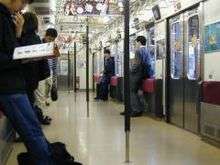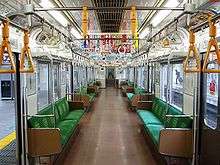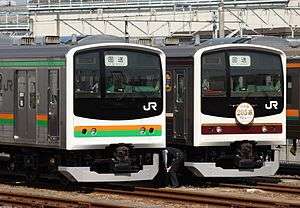205 series
| 205 series | |
|---|---|
|
A 205 series train on the Musashino Line in January 2017 | |
| In service | 1985-present |
| Manufacturer | Hitachi, Kawasaki Heavy Industries, Kinki Sharyo, Nippon Sharyo, Tokyu Car Corporation, JR East Ōfuna Works |
| Replaced | 103 series |
| Constructed | 1984-1991 |
| Number built | 1,461 vehicles |
| Formation | 2, 3, 4, 6, 8 or 10 cars per trainset |
| Operator(s) |
JNR (1985-1987) JR East, JR-West (1987-present) KRL Jabodetabek (2013-present) Fuji Kyuko (2011-present) |
| Depot(s) | Miyagino, Nakahara, Keiyō, Kawagoe, Kōzu, Kamakura, Hineno, Miyahara, Depok, Bukit Duri |
| Specifications | |
| Car body construction | Stainless steel |
| Car length | 20,000 mm (65 ft 7 in) |
| Doors |
4 pairs per side 6 pairs per side (SaHa 204) |
| Maximum speed |
100 km/h (Hanwa Line 205-1000 series 110 km/h) |
| Traction system |
Resistor control + field system superimposed field excitation control Variable frequency (IGBT) (205-5000 series) |
| Electric system(s) | 1,500 V DC overhead lines |
| Current collection method | Pantograph |
| Braking system(s) | Regenerative brake, electronically controlled pneumatic brakes |
| Safety system(s) | ATS-SN,[* 1] ATS-SW,[* 2] ATS-P, ATS-Ps,[* 3] ATC,[* 4] D-ATC[* 5] |
| Coupling system | Shibata-Type |
| Track gauge | 1,067 mm (3 ft 6 in) |
| Notes | |
The 205 series (205系 Nihyaku-go-kei) is a commuter electric multiple unit (EMU) train type introduced in 1985 by Japanese National Railways (JNR), and currently operated by East Japan Railway Company (JR East) and West Japan Railway Company (JR-West).
Operations
(in alphabetical order)
- Hachikō Line: 4-car 205-3000 series sets (x5) (from 2003) (former 205-0 sets modified by JR-East to form shorter trainsets for use in outer suburban services) (have passenger-operated door controls)
- Hanwa Line: 4-car 205-1000 (built by JR-West) series sets (from 1988), 6- and 8-car 205-0 series sets (2006 - 2010, March 2013-) (formerly operated on JR-West Tokaido-Sanyo Local services as 7-car sets)
- Kawagoe Line: 4-car 205-3000 series sets (x5) (from 2003) (rebuilt by JR East from former 205-0 series sets, with passenger-operated door controls) / 10-car 205-0 series sets (from July 1989 - October 2016)
- Musashino Line: 8-car 205-0 series sets (some sets are powered by 205-5000 intermediate motor car units modified from 205-0 with AC motors)
- Nambu Branch Line: 2-car 205-1000 series sets (x2) (from 2002) (rebuilt by JR East from former 205-0 series sets)
- Nikkō Line: Refurbished 4-car 205-600 series sets with toilets (x4) (from March 2013)[1][2]
- Sagami Line: 4-car 205-500 series sets (x13) (from 1991)
- Senseki Line: 4-car 205-3100 series sets (from 2004) (rebuilt by JR East from former 205-0 series sets with passenger-operated door controls, toilets, and passenger seating which can be arranged in either transverse or longitudinal)
- Tsurumi Line: 3-car 205-1100 series sets (from 25 August 2004) (rebuilt from former 205-0 sets)[3]
- Utsunomiya Line: Refurbished 4-car sets with toilets (x8) (from March 2013)[1]
Former operations


- Chuo-Sobu Line: 10-car 205-0 series sets (1989 - 2001)
- Keihin-Tohoku Line: 10-car 205-0 series sets (1989 - 1996)
- Keiyō Line: 10-car 205-0 series sets (from 1990 - 2011)
- Nambu Line: 6-car 205-0 (x31) (including 4 sets with 205-1200 driving trailers which were converted from 205-0 series intermediate trailers) (1989 - 9 January 2016)
- Saikyo Line: 10-car 205-0 series set (from July 1989 - October 2016) (through service to Rinkai Line)
- Tokaido-Sanyō Local service (Biwako, Kyoto, Kobe, Fukuchiyama lines): 7-car 205-0 series sets (1986 - 2006)
- Tokaido Local Service (Kyoto, Kobe lines): 7-car 205-0 series sets (2011 - March 2013) (formerly operated on JR-West Hanwa Line as 6- and 8-car sets)
- Yamanote Line: 11-car 205-0 series sets (1985 - 2005) (initially 10-car sets)
- Yokohama Line: 8-car 205-0 series sets (x28) (1988 - 23 August 2014, initially 7-car sets)[4]
Design variants
There have been many variations of the design of the 205 series trains.
- 205-0 series:
- 205-500 series: 4-car sets used on the Sagami Line
- 205-600 series: 4-car sets for use on the Nikko Line and Utsunomiya Line from 16 March 2013
- 205-1000 series: 6-car JR-West sets
- 205-1000 series: 2-car JR East sets rebuilt from former 205-0 series cars, used on the Nambu Branch Line
- 205-1100 series: 3-car sets rebuilt from former 205-0 series cars, introduced on the Tsurumi Line from 25 August 2004[3]
- 205-1200 series: 6-car sets rebuilt from former 205-0 series cars, used on the Nambu Line
- 205-3000 series: 4-car sets rebuilt from former 205-0 series cars, used on the Kawagoe Line and Hachiko Line
- 205-3100 series: 4-car sets rebuilt from former 205-0 series cars, used on the Senseki Line
- 205-5000 series: Former Yamanote Line 205-0 series cars modified with new VVVF-controlled AC motors between 2002 and 2008, used on the Musashino Line
Below is a list of photos for various 205 series designs as indicated by the liveries of the lines they serve.
JR East
- Yamanote Line 205-0 series set 30 in February 2003
 A Keihin-Tohoku Line 205-0 series in February 1992
A Keihin-Tohoku Line 205-0 series in February 1992 A Saikyo Line 205-0 series in November 2007
A Saikyo Line 205-0 series in November 2007- A Yokohama Line 205-0 series in April 2008
 Musashino Line (left) and Keiyo Line (right) 205-0 series trains in May 2006
Musashino Line (left) and Keiyo Line (right) 205-0 series trains in May 2006- A Nambu Line 205-0 series in April 2011
 A Keiyo Line 205-0 series (later design) in May 2008
A Keiyo Line 205-0 series (later design) in May 2008- Musashino Line 205 series (left, later design) and Sagami Line 205-500 series (right) in November 2006
 A Nikko Line 205-600 series in March 2013
A Nikko Line 205-600 series in March 2013 An Utsunomiya Line 205-600 series in March 2013
An Utsunomiya Line 205-600 series in March 2013- A Nambu Branch Line 205-1000 series in August 2009
- A Tsurumi Line 205-1100 series in August 2009
- A Nambu Line 205-1200 series in October 2014
- A Kawagoe/Hachiko Line 205-3000 series in June 2004
- A Senseki Line 205-3100 series in July 2006
 A Musashino Line 205-5000 series in January 2017
A Musashino Line 205-5000 series in January 2017
JR-West
- A JR-West 205-0 series in original livery in February 2006. Used on the Tokaido Main Line from 1986-2006 as 7-car sets and on the Hanwa Line as 6- and 8-car sets from 2006 to 2010
 A JR-West 205-0 series in Tokaido Main Line livery in March 2011
A JR-West 205-0 series in Tokaido Main Line livery in March 2011- A JR-West 205-0 series in new Hanwa Line livery in January 2014
 A Hanwa Line 205-1000 series train with later design cab window arrangement at Tennoji Station bound for Hineno Station in July 2004
A Hanwa Line 205-1000 series train with later design cab window arrangement at Tennoji Station bound for Hineno Station in July 2004
205-600 series
| 205-600 series | |
|---|---|
|
205-600 sets Y8 (left) and Y3 (right) in March 2013 | |
| In service | 16 March 2013 – |
| Replaced | 107 series |
| Refurbishment | 2012–2013 |
| Number in service | 48 vehicles (12 sets) |
| Formation | 4 cars per set |
| Fleet numbers | Y1–Y12 |
| Operator(s) | JR East |
| Depot(s) | Oyama |
| Line(s) served | Utsunomiya Line, Nikko Line |
| Specifications | |
| Car body construction | Stainless steel |
| Car length | 20,000 mm (65 ft 7 in) |
| Width | 2,800 mm (9 ft 2 in) |
| Doors | 4 pairs per side |
| Maximum speed | 100 km/h (60 mph) |
| Acceleration | 1.7 km/h/s |
| Deceleration | 3.6 km/h/s |
| Electric system(s) | 1,500 V DC |
| Current collection method | overhead |
| Bogies | DT50 (motored), TR235D (trailer) |
| Safety system(s) | ATS-P, ATS-SN |
| Track gauge | 1,067 mm (3 ft 6 in) |
The 205-600 subseries was created in 2013, when cars from former Keiyo Line 10-car sets were reformed between 2012 and 2013 to create twelve four-car sets for use on Nikko Line and Utsunomiya Line services, entering service from 16 March 2013, replacing ageing 107 series and 211 series sets.[5] The four Nikko Line sets are finished in a livery with "classic ruby brown", "gold", and "cream" bodyside stripes.[5] The Utsunomiya Line sets are finished in a livery with Shonan green and orange bodyside stripes.[5]
Formations
The four-car sets, numbered Y1 to Y12, are formed as shown below, with two motored (M) cars and two non-powered trailer (T) cars.[5][6]
| Car No. | 1 | 2 | 3 | 4 |
|---|---|---|---|---|
| Designation | Tc' | M' | M | Tc |
| Numbering | KuHa 204-600 | MoHa 204-600 | MoHa 205-600 | KuHa 205-600 |
| Weight (t) | 25.3 | 34.5 | 33.1 | 26.4 |
| Capacity (Total/seated) | 136/48 | 144/54 | 144/54 | 139/42 |
- The MoHa 205-600 cars are equipped with two PS33F single-arm pantographs.[6]
- The KuHa 205-600 cars have a wheelchair-accessible toilet.[6]
Interior
Passenger accommodation consists of longitudinal bench seating throughout. A universal access toilet was added to the KuHa 205-600 car at the time of conversion.[5]
Fleet list
| Set No. | Livery/line colour | Car numbers | Former set No. | Former car numbers | ||||||
|---|---|---|---|---|---|---|---|---|---|---|
| Y1 | Utsunomiya | KuHa 204-601 | MoHa 204-601 | MoHa 205-601 | KuHa 205-601 | Keiyo 2 | KuHa 204-109 | MoHa 204-295 | MoHa 205-295 | KuHa 205-109 |
| Y2 | Nikko | KuHa 204-602 | MoHa 204-602 | MoHa 205-602 | KuHa 205-602 | Keiyo 1 | KuHa 204-108 | MoHa 204-292 | MoHa 205-292 | KuHa 205-108 |
| Y3 | Nikko | KuHa 204-603 | MoHa 204-603 | MoHa 205-603 | KuHa 205-603 | Keiyo 4 | KuHa 204-111 | MoHa 204-301 | MoHa 205-301 | KuHa 205-111 |
| Y4 | Utsunomiya | KuHa 204-604 | MoHa 204-604 | MoHa 205-604 | KuHa 205-604 | Keiyo 3 | KuHa 204-110 | MoHa 204-298 | MoHa 205-298 | KuHa 205-110 |
| Y5 | Utsunomiya | KuHa 204-605 | MoHa 204-605 | MoHa 205-605 | KuHa 205-605 | Keiyo 6 | KuHa 204-113 | MoHa 204-307 | MoHa 205-307 | KuHa 205-113 |
| Y6 | Nikko | KuHa 204-606 | MoHa 204-606 | MoHa 205-606 | KuHa 205-606 | Keiyo 5 | KuHa 204-112 | MoHa 204-304 | MoHa 205-304 | KuHa 205-112 |
| Y7 | Utsunomiya | KuHa 204-607 | MoHa 204-607 | MoHa 205-607 | KuHa 205-607 | Keiyo 8 | KuHa 204-115 | MoHa 204-313 | MoHa 205-313 | KuHa 205-115 |
| Y8 | Utsunomiya | KuHa 204-608 | MoHa 204-608 | MoHa 205-608 | KuHa 205-608 | Keiyo 7 | KuHa 204-114 | MoHa 204-310 | MoHa 205-310 | KuHa 205-114 |
| Y9 | Utsunomiya | KuHa 204-609 | MoHa 204-609 | MoHa 205-609 | KuHa 205-609 | Keiyo 10 | KuHa 204-117 | MoHa 204-319 | MoHa 205-319 | KuHa 205-117 |
| Y10 | Nikko | KuHa 204-610 | MoHa 204-610 | MoHa 205-610 | KuHa 205-610 | Keiyo 9 | KuHa 204-116 | MoHa 204-316 | MoHa 205-316 | KuHa 205-116 |
| Y11 | Utsunomiya | KuHa 204-611 | MoHa 204-611 | MoHa 205-611 | KuHa 205-611 | Kawagoe 17 | KuHa 204-125 | MoHa 204-341 | MoHa 205-341 | KuHa 205-125 |
| Y12 | Utsunomiya | KuHa 204-612 | MoHa 204-612 | MoHa 205-612 | KuHa 205-612 | Kawagoe 16 | KuHa 204-124 | MoHa 204-338 | MoHa 205-338 | KuHa 205-124 |
Senseki Line "Mangattan Liner" trains
A Senseki Line 205-3100 series "Mangattan Liner" trainset is decorated with images of the cartoon character Robocon from the 1970s anime Ganbare!! Robocon, while another ("Mangattan Liner II") has Kamen Rider livery. Both were created by Shotaro Ishinomori, a native of Ishinomaki, Miyagi; Ishinomaki Station is the terminus of the Senseki Line.
- Senseki Line "Mangattan Liner" trainset (set M8) in July 2006
- "Mangattan Liner II" (set M2) in January 2009
Withdrawal and resale
Fuji Kyuko
A number of former 205 series trains were sold to Fuji Kyuko in 2011 and modified to become 3-car 6000 series sets, entering service from February 2012.[8] Four more withdrawn JR East 205 series cars (KuHa 205-107 + MoHa 205-287 + MoHa 204-287 + KuHa 204-107) were resold to Fuji Kyuko following withdrawal in November 2016.[9]
- Fujikyu 6000 series in February 2012
Indonesia
A total of 476 units (60 sets) from withdrawn Saikyo Line, Yokohama Line, and Nambu Line sets were shipped to Jakarta from late 2013 to early 2016.
Former Saikyo Line sets
A total of 18 withdrawn Saikyo Line ten-car sets (180 vehicles) were shipped to KA Commuter Jabodetabek (KCJ) in Jakarta, Indonesia, in 2013, and entered service from March 2014.[10] The sets in use are former Kawagoe sets 1, 4, 7, 11 to 15, 18, 20, 22 to 26, and 30 to 32. All except sets 26, 30, and 32 include pairs of SaHa 204 cars with six pairs of doors per side.[10] Sets 30 to 32 were originally Yamanote Line sets, distinguished by their smaller door windows.[10] Set 23 was the first set to have a pair of LCD screens inside all cars, except SaHa 204 cars.[11] Set 23 was also the first set to have working LED destination display in KuHa 204 and KuHa 205 cars. Set 15 and 32 were involved in a train accident in Juanda Station, Jakarta.[12]
 10-car former Saikyo Line set 23, June 2016. Note the women only car sticker and sign.
10-car former Saikyo Line set 23, June 2016. Note the women only car sticker and sign.
Former Yokohama Line sets
From July 2014, 22 withdrawn Yokohama Line eight-car sets (176 vehicles) were shipped to Jakarta.[13]
 10-car former Yokohama Line set H12 and 12-car former Yokohama Line set H24+H25, June 2016. Note only women only car sign present.
10-car former Yokohama Line set H12 and 12-car former Yokohama Line set H24+H25, June 2016. Note only women only car sign present.
Former Nambu Line sets
In 2015, 20 withdrawn Nambu Line six-car sets (120 vehicles) were shipped to Jakarta.[14] The former Nambu Line sets are used on 12-car operations.[15]
- 12-car former Nambu Line set 2 and 4, September 2015.
References
- JR全車両ハンドブック2006 [JR Rolling Stock Handbook 2006]. Japan: Neko Publishing. 2006.
- JR電車編成表 '07冬号 [JR EMU Formations - Winter 2007]. Japan: JRR. December 2006. ISBN 4-88283-046-9.
- 1 2 日光線、宇都宮線に205系リニューアル車投入 [Refurbished 205 series to be introduced on Nikko and Utunomiya Line]. Tetsudo Hobidas (in Japanese). Japan: Neko Publishing Co., Ltd. 27 September 2012. Retrieved 28 September 2012.
- ↑ 日光線用205系600番台が出場 [205-600 series for Nikko Line out-shopped]. Japan Railfan Magazine Online (in Japanese). Japan: Koyusha Co., Ltd. 17 October 2012. Retrieved 17 October 2012.
- 1 2 鶴見線に205系先頭車化改造車1100代が登場 [205-1100 series with modified end cars appear for Tsurumi Line]. Railway Journal. Japan: Tetsudō Journal. 38 (457): 92. November 2004.
- ↑ 横浜線用の205系が営業運転を終了 [End of 205 series revenue operations on Yokohama Line]. Japan Railfan Magazine Online (in Japanese). Japan: Koyusha Co., Ltd. 24 August 2014. Retrieved 25 August 2014.
- 1 2 3 4 5 6 Kakuno, Shinichi (July 2013). 205系600番台 [205-600 series]. Japan Railfan Magazine (in Japanese). Japan: Koyusha Co., Ltd. 53 (627): 98–100.
- 1 2 3 JR電車編成表 2013夏 [JR EMU Formations - Summer 2013]. Japan: JRR. May 2013. p. 61. ISBN 978-4-330-37313-3.
- ↑ JR電車編成表 2017冬 [JR EMU Formations - Winter 2017] (in Japanese). Japan: Kotsu Shimbunsha. 16 November 2016. p. 60. ISBN 978-4-330-73716-4.
- ↑ JR車両のうごき [JR rolling stock changes]. Tetsudo Daiya Joho Magazine (in Japanese). Vol. 46 no. 395. Japan: Kotsu Shimbun. March 2017. p. 128.
- 1 2 3 Hosoya, Kazuhiko (June 2014). インドネシアの205系 営業運転開始 [Indonesia's 205 series enter revenue service]. Japan Railfan Magazine (in Japanese). Japan: Koyusha Co., Ltd. 54 (638): 142–143.
- ↑ "KCJ Pasang SIP di Kereta dan Stasiun" [KCJ Installs Commuter Information System Display in Trains and Stations] (in Indonesian). Indonesia: Seputar Indonesia. 16 October 2014. Retrieved 3 July 2016.
- ↑ "KRL Kecelakaan di Stasiun Juanda" [Commuter Train Accident Occurred in Juanda Station] (in Indonesian). Indonesia: Berita Satu. 23 September 2015. Retrieved 3 July 2016.
- ↑ Takagi, Satoshi (November 2014). ジャカルタの205系 [Jakarta's 205 series]. Japan Railfan Magazine (in Japanese). Japan: Koyusha Co., Ltd. 54 (643): 105–111.
- ↑ "PT KAI Commuter Jabodetabek Rampungkan Pembelian kereta Bekas Jepang" [PT KAI Commuter Jabodetabek completes purchase of used Japanese trains] (in Indonesian). Indonesia: Suara Pembaruan. 5 December 2014. Retrieved 14 January 2015.
- ↑ "Lagi, 24 Unit KRL dari JR East Jepang Tiba di Pelabuhan Tanjung Priok" [Again, 24 Units of EMU from Japanese JR East Arrived in Port of Tanjung Priok] (in Indonesian). Indonesia: Infonitas. 5 August 2015. Retrieved 6 August 2015.
Further reading
- Ikeguchi, Eiji (18 September 2015). 205系物語 [The 205 Series Story] (in Japanese). Tokyo, Japan: JTB Publishing. ISBN 978-4533106743.
External links
| Wikimedia Commons has media related to JNR 205. |
- JR East 205 series (in Japanese)



